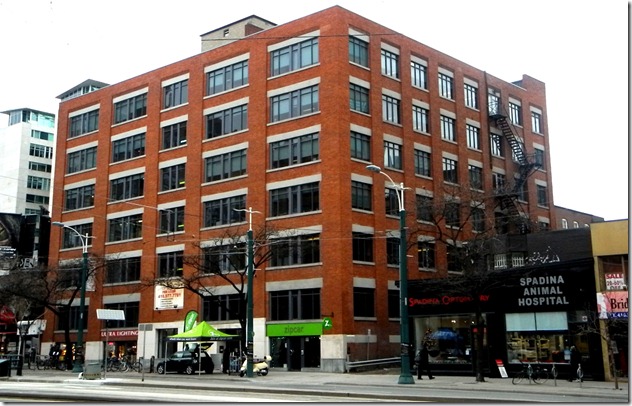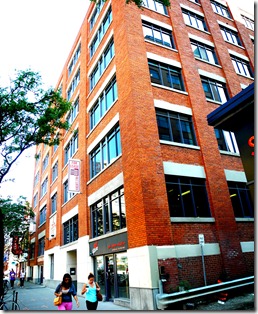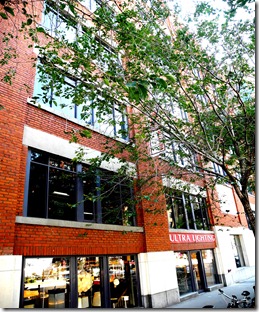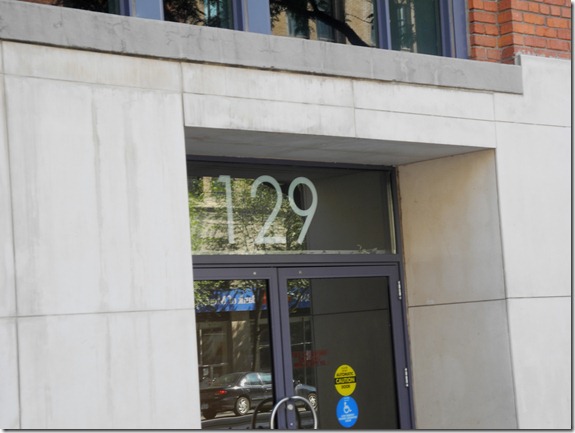The impressive Spadina Building is a warehouse/loft structure on Spadina Avenue, between King West and Richmond Streets, are reminders of the garment industry that flourished in the area in past decades. It is one five major buildings brick building on Spadina near Richmond Streets, occupying land at 129-139 Spadina. Its facade is relatively unadorned, the white stone lintels above the large rectangular windows the only detailing that the architect added. However, despite the building’s plain exterior, it is a handsome structure that is worthy of recognition.
In the early days of the twentieth century, Richmond Street West terminated a Peter Street. It had not yet been extended west to Spadina. Residential homes were on the east side of Spadina, the present-day site of the Spadina Building. In 1920, at 129 Spadina lived Mrs. Margaret Angus, and at 131 was John B. Larocque, but the houses at 133 and 135 were unoccupied. These houses were demolished, and in 1921 appeared the large aware warehouse building named the Spadina Building. Along with the four other commercial buildings in the area, it dominated the street, and this remains true today.
In 1922, the following companies had located their workspace within the Spadina Building – A. J. Victor, ladies waists – Sterling Woollen and Silk – Lion Dress and Ladies Wear – Winston John and Co., publishers – R.J. Sopera and Company, dresses – Counter Costume Company – William Milne, men’s wear – L. Marcus, wholesale woollens – United Paper Mill Ltd. – and Copp Clark Co. Ltd., book department
Today, the building still provides office and warehouse space for many different companies.
Detailing on the facades of the Spadina Building
The unadorned entrance to the Spadina Building, which was likely altered at some time during the past few decades.
To view the Home Page for this blog: https://tayloronhistory.com/
Links to other posts about the history of Toronto and its buildings:
https://tayloronhistory.com/2013/10/08/links-to-historic-architecture-of-torontotayloronhistory-com/
Links to posts about Toronto’s movie houses—past and present.
https://tayloronhistory.com/2013/10/09/links-to-toronto-old-movie-housestayloronhistory-com/
Recent publication entitled “Toronto’s Theatres and the Golden Age of the Silver Screen,” by the author of this blog. The publication explores 50 of Toronto’s old theatres and contains over 80 archival photographs of the facades, marquees and interiors of the theatres. It also relates anecdotes and stories from those who experienced these grand old movie houses.
To place an order for this book:
Theatres Included in the Book
Chapter One – The Early Years—Nickelodeons and the First Theatres in Toronto
Theatorium (Red Mill) Theatre—Toronto’s First Movie Experience and First Permanent Movie Theatre, Auditorium (Avenue, PIckford), Colonial Theatre (the Bay), thePhotodome, Revue Theatre, Picture Palace (Royal George), Big Nickel (National, Rio), Madison Theatre (Midtown, Capri, Eden, Bloor Cinema, Bloor Street Hot Docs), Theatre Without a Name (Pastime, Prince Edward, Fox)
Chapter Two – The Great Movie Palaces – The End of the Nickelodeons
Loew’s Yonge Street (Elgin/Winter Garden), Shea’s Hippodrome, The Allen (Tivoli), Pantages (Imperial, Imperial Six, Ed Mirvish), Loew’s Uptown
Chapter Three – Smaller Theatres in the pre-1920s and 1920s
Oakwood, Broadway, Carlton on Parliament Street, Victory on Yonge Street (Embassy, Astor, Showcase, Federal, New Yorker, Panasonic), Allan’s Danforth (Century, Titania, Music Hall), Parkdale, Alhambra (Baronet, Eve), St. Clair, Standard (Strand, Victory, Golden Harvest), Palace, Bedford (Park), Hudson (Mount Pleasant), Belsize (Crest, Regent), Runnymede
Chapter Four – Theatres During the 1930s, the Great Depression
Grant ,Hollywood, Oriole (Cinema, International Cinema), Eglinton, Casino, Radio City, Paramount, Scarboro, Paradise (Eve’s Paradise), State (Bloordale), Colony, Bellevue (Lux, Elektra, Lido), Kingsway, Pylon (Royal, Golden Princess), Metro
Chapter Five – Theatres in the 1940s – The Second World War and the Post-War Years
University, Odeon Fairlawn, Vaughan, Odeon Danforth, Glendale, Odeon Hyland, Nortown, Willow, Downtown, Odeon Carlton, Donlands, Biltmore, Odeon Humber, Town Cinema
Chapter Six – The 1950s Theatres
Savoy (Coronet), Westwood
Chapter Seven – Cineplex and Multi-screen Complexes
Cineplex Eaton Centre, Cineplex Odeon Varsity, Scotiabank Cineplex, Dundas Square Cineplex, The Bell Lightbox (TIFF)




![cid_E474E4F9-11FC-42C9-AAAD-1B66D852[1] cid_E474E4F9-11FC-42C9-AAAD-1B66D852[1]](https://tayloronhistory.com/wp-content/uploads/2014/09/cid_e474e4f9-11fc-42c9-aaad-1b66d8521_thumb39.jpg)


Another company that was located at 129 Spadina was J.H. Bardwell… women’s clothing… I should know… I worked there one summer in the 1970’s, and so did my dad for many years until it closed down.